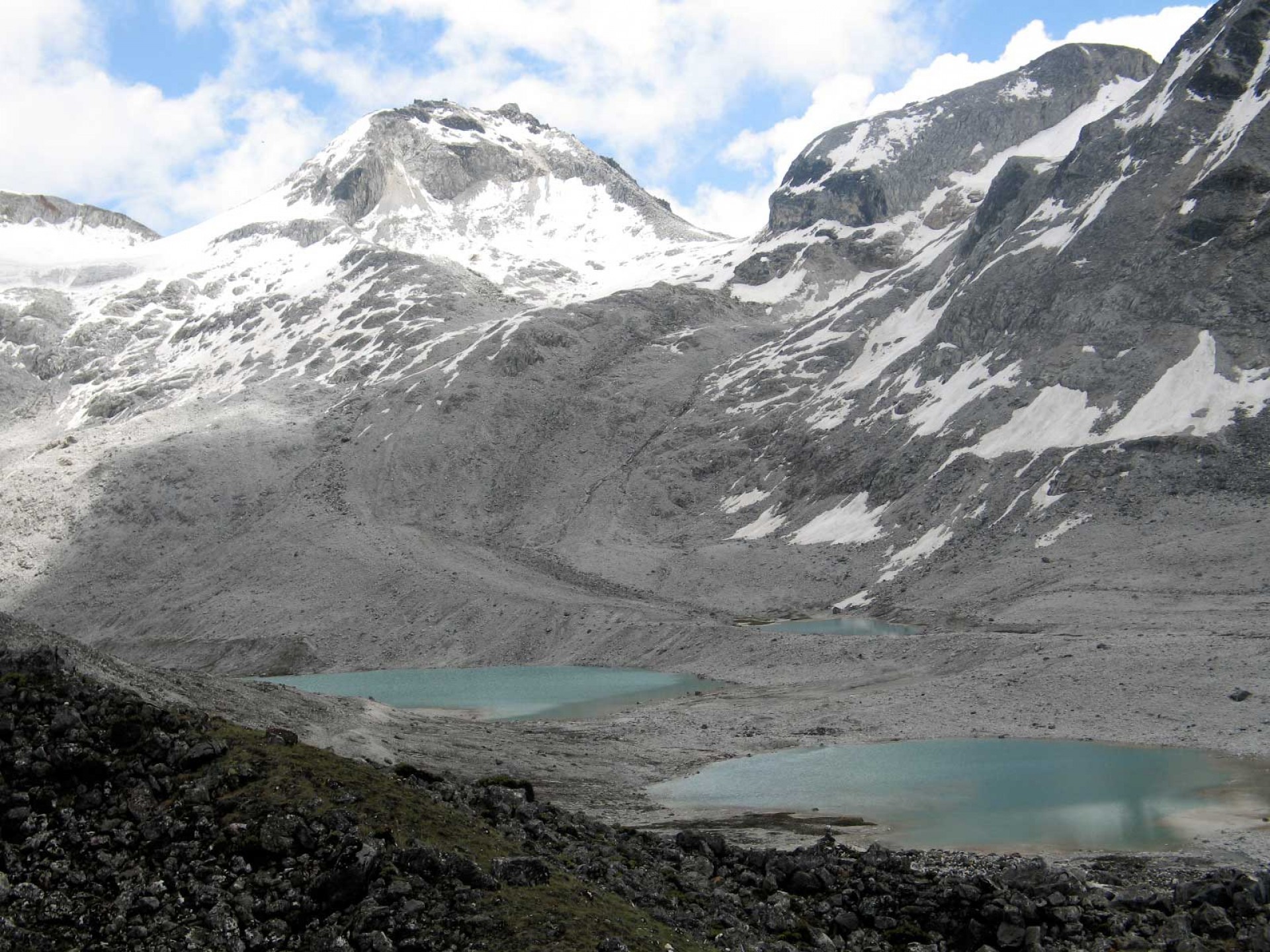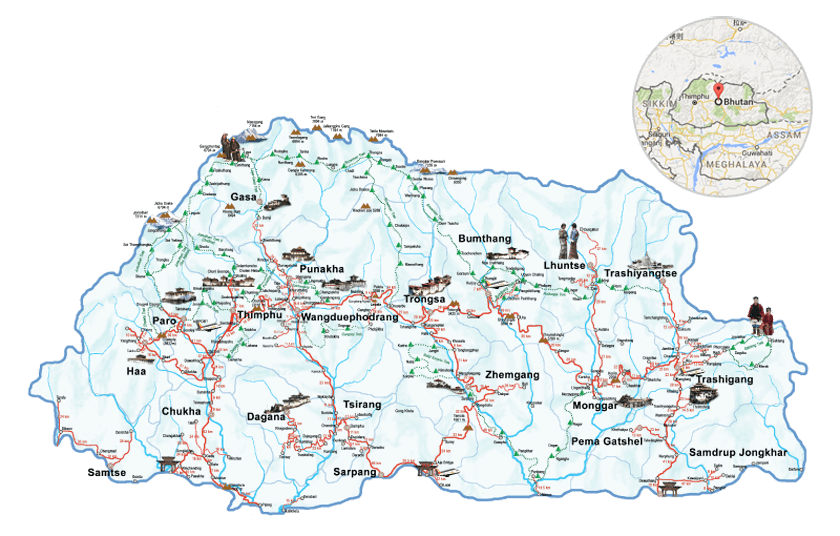Trekking
Lunana Snowman Trek 28 Days

The Snowman trek is of legend. While it is renowned for its wild beauty, it’s a strenuous and remote undertaking. You’ll pass Bhutan’s graceful, second highest mountain Chomolhari, meet Layaps and Lunaps, isolated semi-nomadic yak herders, recognisable for their unique head wear, and otherwise become fully acquainted with life in the untouched Bhutanese Himalayan range which few outsiders ever get to see.
- DURATION: 28 Days
- DIFFICULTY: Hard
- DESTINATION: Lunana Snowman
- MAX ALTITUDE: 5,050 m
- ACCOMODATION:
- GROUP SIZE: Any number
- TRIP STARTS AT: Paro
- TRIP ENDS AT: Paro
- BEST SEASONS:
Trip Overview
The Snowman trek is of legend. While it is renowned for its wild beauty, it’s a strenuous and remote undertaking. You’ll pass Bhutan’s graceful, second highest mountain Chomolhari, meet Layaps and Lunaps, isolated semi-nomadic yak herders, recognisable for their unique head wear, and otherwise become fully acquainted with life in the untouched Bhutanese Himalayan range which few outsiders ever get to see.
TOUR MAP AND ITINERARY

Day 1 :
You will get an incredible view of the Himalayas including the mountains you’ll be trekking close to, Mount Jhomolhari and Jichu Drake as your Druk Air flight approaches the Paro valley. The Paro valley is approximately 2,250 m above sea level and is considered the food bowl of Bhutan. The valley is dotted with traditional village chalets. You will be received at the airport by your guide and driven to your hotel through the beautiful Paro valley.
- Overnight at hotel.
- Hotel
Day 2 :
You will drive up the Pa Chu (Paro river) to Drugyel Dzong, which means the ‘victory fort’, which is now in ruins. The fort was built to commemorate Bhutan’s victory over Tibet. On a clear day you will see Mt. Jhomolhari, the sacred mountain of Bhutan pushing up above the pine forests. Perched on a cliff on your right you will see Taktshang (Tiger’s nest); one of the most astonishing monuments of Bhutan. Legend has it that the Indian Saint Padmasambhava, Guru Rinpoche, rode on the back of a tigress to Taktshang. From Drugyel Dzong we will drive to see the Ta Dzong (Paro Museum).
Day 3 :
Your trek starts today at Drugyel Dzong. The trail passes through the village of Tsento and follows the Paro river. Temperate forests soon replace the farmlands of Paro. Blue pine, laryx and oak are common tree species along the trail. Today’s walk is a pleasant one with no major climbs. You will camp beside an army outpost.
- Altitude 2,800 m. Distance 17 km. Approximate time 5-6 hours.
- 2,800 m
- 5-6 Hours
Day 4 :
Today you will continue uphill through the river valley. The trail is a tedious one but one is mostly engrossed in the surrounding vegetation. Overnight in camp.
- Camp
Day 5 :
You will trek up the valley towards the source of the Pa Chu. This is a light walking day and most refreshing after the previous day’s walk On the way you will see a small army post from where the valleys widens again. High ridges and snow-capped peaks surround you and the lush temperate forests are replaced with hardy alpine flora, mostly rhododendrons. It is estimated that there are more than 50 species of rhododendrons in Bhutan. You will also walk through a yak herder’s settlement. Small, scattered herds of Blue sheep are often sighted. Camp at the base of Mt. Jhomolhari.
- Alt. 4,040 m. Distance 19 km. Approximate time 5-6 hours.
- 4,040 m
- 5-6 Hours
Day 6 :
Explore the area around the base of Jhomolhari. In the evening walk up to the Tsophu lakes.
Day 7 :
Tsherimgang and its descending glaciers at the north end of the valley are a constant sight. You pass the Nela La (Alt: 4,572 m) and have lunch on the other side. If the weather is clear, you will get great views of the Lingshi Dzong and the Lingshi basin. The area around Lingshi is full of medicinal plants. Plans are underway to build a herbarium in Lingshi in order to make the collection of medicinal plants more sustainable. Overnight at camp.
- Alt. 4, 150 m. Distance 19 km. About 5-6 hours.
- 4,150 m
- 5-6 Hours
Day 8 :
Today is the shortest walking day. On reaching camp at Chebisa village you can visit the village houses. Chebisa is a picturesque village with a waterfall in the backdrop. Today’s walk is the best for photographing Blue Sheep. Herds with as many as 300 Blue Sheep have been sighted between Lingshi and Chebisa.
- Alt. 4, 260 m. Distance – 19 km. About 5-6 hours.
- 4,260 m
- 5-6 Hours
Day 9 :
The walk is through wild alpine pastures crossing Gobu La (pass).
- Alt. 4, 260 m. Distance – 15 km. About 5 hours.
- 4,260 m
- 5 Hours
Day 10 :
Starting earlier than usual and after crossing Jare La (alt. 15,088ft/4600m), you drop to Tsharijathag, the valley where herds of Takin are seen in the summer. Takin is the national animal of Bhutan.
- Alt. 4,389 m. Distance – 15 km. About 5 hours.
- 4,389 m
- 5 Hours
Day 11 :
After crossing Shinche La (alt. 4,900) you drop down again and follow the valley. Camp at Lemithang beneath Gangchetag La (Great Tiger Mountain).
- Alt. 4,135 m. Distance – 19 km. About 7/8 hours.
- 4,135 m
- 7-8 Hours
Day 12 :
Today is all the way down hill along a narrow river valley. You camp on a high flat bench above the east end of the Laya village.
- Alt. 3,678 m. Distance – 10 km. About 5-6 hours.
- 3,678 m
- 5-6 Hours
Day 13 :
Visit the village houses and mingle with the local people.
Day 14 :
Alt. 4,160 m . Distance – 19 km. About 6-7 hours. Overnight in camp.
- 4,160 m
- Camp
- 6-7 Hours
Day 15 :
Alt. cross Tsimo La pass (4,220m). Distance – 17 km. About 5-6 hours. Overnight in camp.
- 4,220 m
- Camp
- 5-6 Hours
Day 16 :
Cross Gangla Karchun, Alt. 5,100m. Distance – 18 km.. About 6-7 hours.
- 5,100 m
- 6-7 Hours
Day 17 :
On arrival at camp, visit a village house of Woche. The Lunana area begins from here.
- Distance 15 km. About 5 hours. Overnight in camp.
- Camp
- 5 Hours
Day 18 :
Cross Kache La, Alt. 4,550 m. Distance 19 km. About 6-7 hours. Stop at Thega Village enroute. Overnight in camp.
- 4,550 m
- Camp
- 6-7 Hours
Day 19 :
En route this day we visit Chenzo Dzong.
- Alt. 4,050 m. Distance – 19 km. About 5-6 hours. Overnight in camp.
- 4,050 m
- Camp
- 5-6 Hours
Day 20 :
Visit village houses and mix with the people of Thanza or hike in and around the camp or to the Lunana lakes. The Lunana lakes pose a great threat to Bhutan as the source of floods from glacial lake outbursts. Overnight in camp.
- Camp
Day 21 :
Today’s trail is dotted with turquoise blue alpine lakes.
- Alt. 4,800 m. Cross Jaze La, Alt. 5,050 m. Distance 18 km. About 6-7 hours.
- 5,050 m
- 6-7 Hours
Day 22 :
Alt. 4,880 m. Cross Loju La, Alt.4, 940 m. Distance – 20 km. About 6-7 hours. Overnight in camp.
- 4,940 m
- Camp
- 6-7 Hours
Day 23 :
The Tempe Tso area is a good place to photograph the national flower, the Blue Poppy in July-August. Pass the Umtsho Lake from which Terton Pemalingpa found religious treasures. For avid birdwatchers, this area is where your binoculars will be well used.
- Cross Tampe La, alt. 4,550 m, Distance –20 km About 7-8 hours. Overnight in camp.
- 4,550 m
- Camp
- 7-8 Hours
Day 24 :
Today we make a lot of decent through thickets of rhododendrons. Alpine lakes and little valleys make the day’s walk pleasant. You camp on the banks of the Nikka Chu. This is the camp where your yak’s men from Lunana leave and local horsemen from the Sephub village take over. This area is also good for bird watching.
- Alt. 3,610 m. Distance – 14 km. About 5 hours
- 3,610 m
- 5 Hours
Day 25 :
Today’s walk is along the banks of the Nikka Chu. This is another good day for bird watching. You will also encounter Sephub yak herders. Today is your last walking day and although a long day you’ll be a little relieved to get to the end of the trail where your car await. The trail passes through rich subtropical forests and the village of the Sephub people.
- Alt. 2, 650 m, distance – 23 km. About 6-7 hours. Overnight camp at Chendebji Chorten.
- 2,650 m
- Camp
- 6-7 Hours
Day 26 :
Early morning drive to Thimphu through Wangdue Phodrang where we take lunch and see the Wangdue Phodrang Dzong. This Dzong is perched on a ridge above the Puna Tsang Chu and is locally known as the Fortress of the Sleeping Elephant. The drive to Thimphu passes through Lobesa which is a wide, primarily agricultural valley. On a clear day one can get a panoramic view of the Bhutan Himalayas from the Dochu La.
- Alt. 2,350m. About 5-6 hrs driving. Overnight in hotel, Thimphu.
- 2,350 m
- Hotel
- 5-6 Hours
Day 27 :
You get a full day of sightseeing and shopping in Thimphu. Today is the day to relax and wander around the capital of Bhutan. We can visit the handicraft workshop where its easy to buy some lovely gifts. After lunch we’ll visit the Memorial Chorten, Changangkha Lhakhang and Zilukha Nunnery. Overnight at hotel.
- Hotel
- Lunch
Day 28 :
Drive to Airport for onward flight.
WHAT'S INCLUDED
- Accomodation on twin sharing
- All transfers and sightseeing as on itinerary
- Three meals a day
- English speaking local tour guide
- Sightseeing admission fees
- Bhutan visa fee
WHAT'S Not INCLUDED
- Internal and international airfare costs (airfare is separately quoted)
- Expenses of personal nature such as drinks, tip, laundry, phone, etc.
- Extra expenses due to nature and unforeseen events.
- Travel Insurance
TRIP HIGHLIGHTS
-
Spectacular view of Mountains
-
Drugyel Dzong
-
Wonderful view of river valley
-
Source of the Pa Chu
-
Tsherimgang and its descending glaciers
-
Herds of Takin
Discover Bhutan
The Snowman Trek is an extension of the beautiful Laya Gasa Trek, and leads from Laya into high altitudes of the Bhutanese Himalayas.